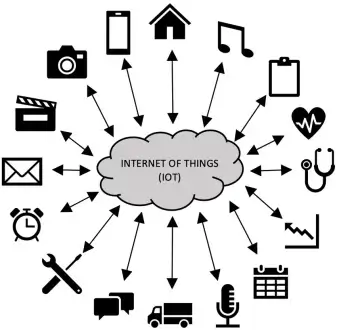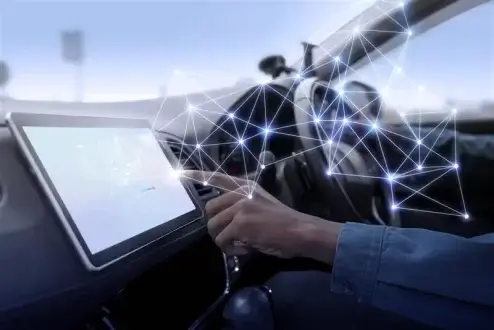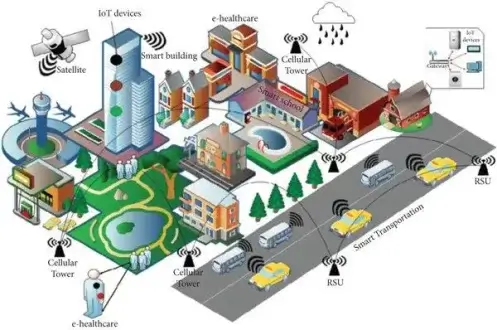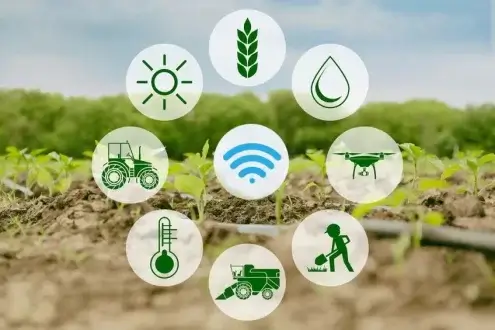Imagine when you wake up you have a bathtub ready with hot water and milk in your refrigerator at the appropriate temperature you prefer and you can do other work after putting your bread in the toaster without having to worry about when to turn it off, your car connected showing you the direct route to your office and your life simplified at each step this way. This is the practical answer to ‘What is Internet of Things?’
Everything today is in some way connected to the internet. There are sensors attached to most of the devices, and the cost of these devices is becoming cheaper day by day. The technology is easily accessible, and all these things are creating a perfect atmosphere for this latest wave of the internet of things.
What is Internet of Things?

“The Internet of Things is a network of devices: electric appliances, home appliances, smart gadgets, machines, vehicles, and many more, that use sensors and APIs to connect and exchange data over the internet.”
The concept of IoT is so broadly defined that it often leaves everyone in a dilemma. The basic point to understand ‘what is IoT?’ is to know that the internet is ruling in every field today. For instance, you’re reading this blog on your laptop or your computer, or your phone through the internet. Before the invention of smartphones (basically the cell phones with internet), we sure had phones that covered our needs of calling and texting, but now that we have the internet, we use our phones to do anything; listen to any song, read a book, watch a movie.
Well, the list does not end there. Today, with the help of the Internet of Things, we can do a lot of other things that were never even thought of before. The internet has helped us connect various devices and transform the data through this network. The internet is not limited to phones, laptops, or computers. Today, anything and everything can be connected to the internet. Yes. Everything. All the devices and machines have sensors from a pin to self-driving motorcars.
Also, it is not just about easing our lives with smart devices like home automation appliances or automatic garages; it’s about automation in various fields. For instance, IoT can be highly useful in the farming industry; it could automate the machines to detect the moisture of the soil and help in irrigation, likewise. The list can be never-ending, which we will further see in detail in “Internet of Things Applications.”
What is an IoT device?
Any device that is connected to the internet and has sensors and can be controlled and monitored from a remote location through the authority device can be considered an IoT device. With the advancements in technology, the devices are becoming smaller, and therefore, the production parts are also small. With such smaller chips, it has become easy to make devices automatic and connected. Hence, almost every device can become an IoT device.
In a nutshell, the Internet of Things has the power to expand the usage of the Internet beyond smartphones and computers, and laptops. It has now extended to a whole new range of machines and devices that are connected through the internet. They send information or receive information, or do both. In this way, IoT is helping businesses and people to connect to the world around them and automate things for improved results.
History & Facts of Internet of Things
- The Internet of Things started in 1982 with the automatic Coke vending machine at Carnegie Mellon University. It was the first machine that was connected to the internet and would report about the inventory, and also keep track of whether the loaded drinks are cold or not.
- The term Internet of Things was brought to light by Kevin Ashton in 1999.
- After many other scientific and technical articles were published on IoT, Cisco Systems estimated that IoT was born between 2008 and 2009.
- RFID (Radio Frequency Identification) played an important role in the formation of the Internet of Things.
- Then came M2M, the telecommunication wave which brought connectivity and development in newly deployed 3G and 4G networks.
- In a decade, the internet of things has transformed in a huge manner. The transformation has taken place in automating things that were never even expected to have an internet connection at all, are now transmitting data, and can be automatically handled from smartphones.
- It is also suggested by a research firm that by 2026, there will be more than 26 billion connected devices. (which is a huge amount!)
Benefits of the Internet of Things
After knowing ‘what is IoT?’, you must already be impressed by how things have started working this way. The technology has worked its way to automate almost everything around us. These devices can now connect to the internet and transfer data over the internet. They work on commands through the authority device and have many advantages that could ease our personal as well as professional life. Below are the top six advantages of this technology.
Automation & Control
With the help of IoT, machines are automatically working with connection to each other. The connected devices are set to automatically perform tasks assigned by humans. Even without human intervention, the gadgets can transfer data with each other based on their programming. In this way, the devices can be controlled without physical contact
For instance, home automation facilitates operating appliances through a smartphone. A bulb can be turned off without you having to turn off the switch by just using your home automation app on your smartphone. This way, IoT helps in automation as well as control.
Connectivity
As we discussed above, the devices can now be connected to the internet, including machines that were thought impossible to have one. The connectivity is not just about the internet connection, though; the devices can now be connected to other devices as well, like phones. IoT was born out of M2M, and it continues to expand its progeny. These connected devices can send and receive data and may also work on each other’s commands. Hence, multiple things can be connected to and operated from one device.
Efficiency along with Convenience
IoT devices have made life easier and more convenient. You just have to signal your consent, and the devices reorder things according to your convenience. Devices like Amazon’s Alexa have made it easier to get more updates and news without turning on your phone or computer. The increased connectivity and artificial intelligence of these devices have enabled processes to run faster and have even eliminated the need for manually operating devices separately.
Conservation
One of the biggest advantages of IoT devices is conservation. This technology can help save energy and resources otherwise be wasted due to untimely operations. These devices can also monitor serious conditions like electricity/water usage/wastage, the atmospheric conditions of a particular area, traffic in a city, the environmental conditions, and other aspects. These devices can also alert to breakdowns and system damage.
The first-ever internet-connected vending machine provided reports regarding its inventory. This way, with the help of these devices, energy and resource conservation is possible, which in turn helps us save time and money.
Personalization
The IoT devices work quite well like their parent technology. Like many websites on the internet that gather data through cookies on their website, which are later used to save your preferences and display similar products or links to similar websites and your searches, IoT devices also work the same way. They store your preferences and personalize your data. These smart devices can quickly process your likes and dislikes and similarly offer services. These personalizations are more preferable as they are more relevant and enjoyable.
Monitoring & Information
As already suggested in the above points, the IoT devices help us monitor several situations and take precautions for possible damages, and can help us save resources. This way, it provides more information that can help in making decisions. Along with information, it monitors the necessary things. For instance, your refrigerator can monitor if you’re low on milk and could pass on this information to your smartphone while you’re away, which could help you save an extra trip to the grocery store.
After looking at these benefits, one could easily make out that this technology is changing the way we live and the way we work. It has brought revolutionary changes in various fields with its automation and monitoring features. Let us have a look at the fields where the Internet of Things is applied.
Internet of Things Applications
Imagine if your car is connected to your calendar and takes the fastest route to your work on the day of your meeting; if you’re stuck in traffic and your car sends a message to your clients that you will be late without you having to worry about it; what if your alarm wakes you up and notifies your coffee maker to brew coffee for you?
All this might sound a little bit like a sci-fi movie to you, but the technology is here, and we are all on the verge of changing the way our lives function. The Internet of Things is not just another new technology; it is the Next Big Thing!
Smart Home

Just like smartphones, with the help of the Internet of Things, it has become possible to add intelligence to other devices as well. The internet helps these devices to transfer data. With this, home appliances now have access to the internet. Automation has become the key to smart devices.
For instance, you could unlock your door if your friends arrive early for a weekend stay when you’re not at home, or you can switch off the lights in your room while you’re at work that you forgot to before leaving for work. These simple, smart home products are revolutionizing residential spaces. Companies like Nest, Ecobee, Ring, and August, with many others, are delivering these experiences to people who believe in the latest technologies.
Smart Cars

After the innovations in home appliances, it has become obvious to look forward to more and more innovations in other fields as well. The automobiles are the next topic to talk about!
The latest talk in the market has been of smart cars. The Internet of Things has helped huge automobile companies like Tesla and BMW, with the help of Google and Apple, bring change to the industry. Today, there are connected cars available in the market that optimize their maintenance, operations like automatic parking, automated gears, and also the comfort of the passengers. There are many other areas in which automation will be seen shortly, like self-driving cars!
Smart cities

A smart city is just another application in which IoT can be highly utilized. Like connected home appliances, devices across the city can be connected to the internet to have better analytical information regarding energy resources being used by the population. It can also solve problems like pollution, traffic congestion, parking spot facility, and other pieces of information can be gathered through this.
Smart surveillance, security, energy management systems, water resource management, and many other areas can be covered in this field. This way, IoT can be useful to monitor resources and help automate things to facilitate the government.
Smart Agriculture

With the increased population, the food supply needs have also increased, and with this, the government is focusing more on advancing the agricultural processes by giving the farmers advanced equipment and techniques for food research and production.
There is automated equipment in the market that could sense the moisture in the soil and control water usage. Other types of equipment could determine fertilizer needs. Stock monitoring and inventory management are also some simple IoT tools that can be used in the farming and agriculture industry.
Other than these, the Internet of Things can have broader usages in other industries as well. It can be used in retail stores, defense, transportation, logistics, and many other.
You may like to read – 10 Entrepreneurial Traits That Succeed
The Future of IoT
It is estimated that by 2025, there will be more than 64 bn IoT devices in the world. It is also expected from minority believers that Blockchain within IoT will populate the marketplaces. The Internet of Things providers are also focusing on using the 5G networks for lightning speed. The future of the Internet of Things is much higher and fascinating than this. There will be billions of things connected without human interference. This will bring on huge changes in the world!
You may like to read – What is Blockchain and How Does Blockchain Work?
Share Your Thoughts With Us!
How well did you like reading our blog “Captivating Observations on the Internet of Things”? Are you aware of any latest news about IoT that we missed out on? Let us know in the comments section below.


Great information. keep posting such a piece of valuable information.
Woah, This is really Insightful & resourceful. Thanks for the Info.
Very informative blog related to IoT. Nowadays even wearable devices are installed with sensors and softwares which collect data and information about the users.
Impressive!Thanks for the convincing post. Your blog explains everything in detail regarding Internet of Things. Keep it up.
Highly recommend this post to all. Your blog is full of information. Great Post